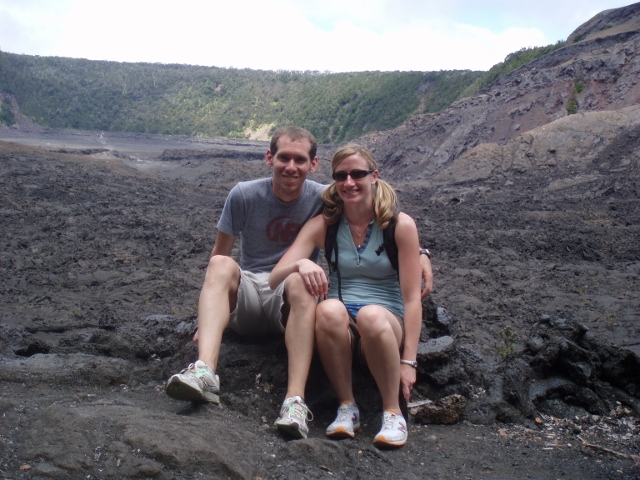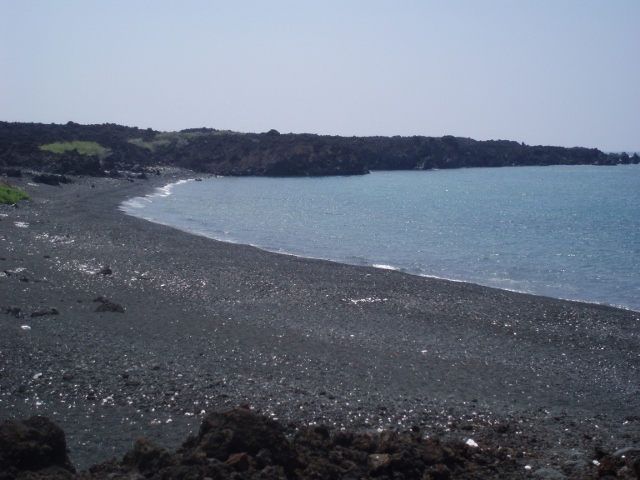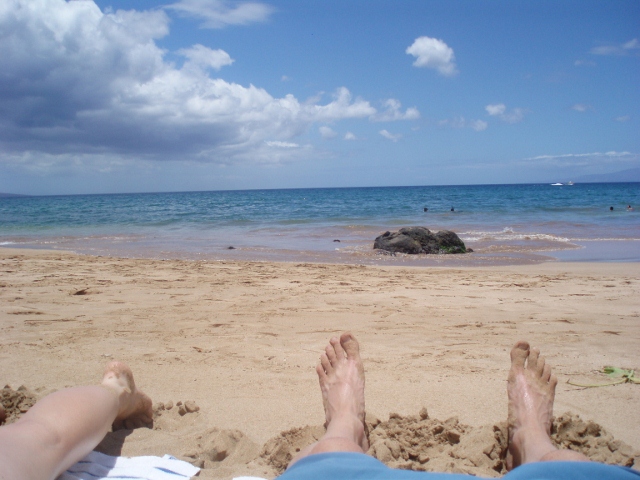Runners say it all the time:
“I was getting in such great shape… but then I went on vacation!”

My wife Meaghan and I sitting on a volcanic lake during our honeymoon
It makes sense that runners get lazy when they leave their routine: early cocktail hours, pressure from friends and family to “just relax,” and a schedule full of fun make running regularly difficult.
How can you train normally when you’re going on a cruise or road trip? The simple answer is that you can’t.
But you don’t have to train at your regular level to stay in good shape. You can maintain your fitness by modifying your training, cutting it dramatically, and then enjoying your vacation as a time to have fun.
This is why I created the free guide, How to Stay Fit on Vacation: A Simple Guide to Maintaining Fitness While You’re Sipping Cocktails.
Ok, I know the name is a little long. But this 26-page, value-packed tutorial will help you focus on the specific workouts that matter while leaving more time to spend time with your family or friends. I had the idea when I was on my honeymoon in Hawaii and trying to stay in good shape to start marathon training for Philadelphia.
After one too many coffee cocktails at night, I couldn’t sleep and spent three hours typing the outline of the guide.
How to Stay Fit on Vacation is 100% free to my readers.
Want it now? Download it Now!
Here’s a preview:
Stay Fit While Barely Exercising: Three Simple Principles
If you’re like me, you like to work hard and play hard. But when I’m on vacation and playing hard (hiking lava lakes and/or dominating Pina Coladas) every day, I like to take a break from working hard. You can’t go full steam ahead all the time.
I want to remind you that if you go on vacation with your significant other or family, your first priority should NOT be running. It should be spending time away from the bustle of everyday life with your loved ones.
With that said, for vacations of 1-2 weeks, you can absolutely maintain your current fitness level by doing next to nothing – just a few targeted workouts per week. And they’ll only last a fraction of your typical training time.
Principle 1: Work out in the morning
Some of us are morning runners while others prefer the afternoon or early evening. But on vacation, I highly recommend that you run in the morning. It’s best to get it out of the way while you’re fresh and likely caffeinated.
Afternoons carry with them more obligations, happy hours, tired legs, less motivation, and small adventures that you didn’t plan on in the morning (like spending two hours hiking to a 400 foot waterfall, in my case). When we got back to the hotel, it was dark and I was exhausted.
Finding the energy to fit in a short workout is half the battle to staying fit when you’re traveling. Do yourself a favor and train in the morning, even if you’re normally an afternoon runner. Leaving it to later is asking for a skipped workout.
This principle is even more important for those who might be doing a lot of hiking. Hiking takes a lot of effort and technical trails can leave your legs feeling like rubber. Running afterwards is not recommended – the fatigue can negatively affect your form, making you much more susceptible to an injury.
Principle 2: Never “just” run
It can be easy to roll out of bed in the morning, put on your running shorts, and stumble through an easy 3 miler. But like a workout at home, a vacation workout should include more than just running.
That means a warm-up, your run (including some faster running, if it calls for that), and some core or strength work. But unlike a typical session, you’re only going to briefly touch on each aspect of your workout. Many of the core routines I recommend include a medicine ball or thera-band, but you can do without them for a week or two.
Yes, I’m recommending that you slack off! A shorter warm-up, less total running, a lot less faster running, and only a few strength exercises compared with what you typically do. You have better things to do than work out, so vacation workouts should be just enough to make sure your body remembers what it’s like to get fit.
Principle 3: Focus on the basics
For almost very runner, the basics include running at opposite ends of the spectrum: easy pace and a 95-100% effort. Both types of running will keep your aerobic and neuromuscular systems sharp during your brief down time.
Most runners know how to go for an easy run, but struggle to fit very fast mini-workouts into their training. First things first: fast does not mean hard. A very good fast session might include 4 x 100m strides (barefoot, if it’s appropriate) or 4 x 10 second hill sprints.
Both workouts include less than two minutes of hard running, so you’re not running fast for long. And you’re barely running over 30 seconds for the hill sprints!
Aside from easy running and a few short sprint workouts, it may be appropriate for you to sprinkle in some fast running at race pace. They key here is to do a fraction of what you’d normally do in a typical workout – make it very easy. If your normal workout is 6 x 800m at 10k pace for example, just do 2 x 800m. Feel free to take a little more rest, too.
This is what I did during my vacation and I can tell you that it really works. Just miniaturize everything you’d normally do during a workout (you rarely should skip anything outright) and you’ll still stay in shape. You can also skip race-specific paces and stick to easy pace with strides or hill sprints. For a mere 1-2 weeks, it won’t matter much.
Where to Run?
One of the biggest difficulties of working out when you’re traveling is finding a suitable place to run. Gone are your familiar routes and well-known trails. There’s no perfect answer to this dilemma, but my recommendation is to do what I do: explore!
Now is the time to have fun, stop worrying so much about your pace, and explore your surroundings. Run around your resort, taking in all the sights and sounds. Find a great restaurant a few miles down the road that you can bring your friends to for lunch. Scout out the nearby park and find solace on the softer surfaces. Maybe there’s a local high school nearby where you can run a few quick 400’s.
Below is near where I ran on the Big Island. A black sand beach isn’t a bad place to explore, is it?

A lot of times, you may not have an ideal place to run. I’ve done loops of a very large Holiday Inn parking lot on previous vacations. It was awful, but I wasn’t running for a long time and it got the job done. Luckily, a lot of runners have a GPS watch (like a Garmin Forerunner), so you’ll know how far and fast you’re running.
Plus, you won’t get lost and turn an easy 3 miler into a long run. You probably know that I’m not a big proponent of overusing technology, but in this case it’s probably a good idea to have a smart watch.
If you decide not to get a GPS watch, a strategy I’ve used that works well (even for those with zero sense of direction, like me) is to rely on simple out-and-back runs. Just run down the street for half the time you want to run, and then turn around and come back the same way. It’s boring, but you’ll never get lost! Plus, you can time how fast you run home and have a nice negative split.
For the well-prepared and more calculating runner, a good idea is to look up where you’re staying on Google Maps or Bing. From the satellite map, you can easily find the nearest track, local park, or river (they usually have some type of trail next to it) to run on. A little planning goes a long way.
I was in Denver for a few days and found a great park this way. With well marked cinder paths and lighting along my route (I was running very early in the morning), it was worth the 25 minutes I took to learn about the area.
How to Come Back to Normal Training After Your Vacation
When you come back from your trip and want to resume training, you can usually begin training at the same volume and intensity as before you left. This is only true if you were gone for 1-2 weeks. Your fitness, both aerobically and structurally, doesn’t decrease much until after the two week mark.
My recommendation is to pick up right where you left off and repeat the same week that you had before you left. I wouldn’t build on that last week, but repeating it ensures that you’re not doing too much, too soon. During that first week back from your trip, pay careful attention to your body during your runs – especially your faster workouts and long runs. If anything is too sore, too tight, and much more difficult than usual, then be cautious and back off. It’s better to take it easy for a day or two than have to take a week or two off with an injury.
If your vacation was longer than two weeks, you need to ease into your previous training volume. My recommendation is about 10-20% less volume and one less workout than you did the week before you left. Be cautious! Being a successful distance runner is more about patience than aggressively trying to run more and more.
When you do your long run, reduce the mileage by 1-3 miles for that first week back, and then go back up to your previous long run distance during the next week. I’m much more careful with hard workouts: if you didn’t do any during your vacation, drop one from your first week back.
And if you only did one hard workout during a typical week, reduce the volume of fast running and slow the pace down slightly. Here’s one example: instead of 6×800 at 5k pace, run 5×800 at 8k pace. Don’t over think this, but be smart and over-conservative. Patience will pay off in droves when you’re healthy and consistently training.
Different Vacations, Different Training Plans

As you think about the type of training you’re going to be doing while on vacation, remember that the type of vacation will affect how you’re able to run and train. Road trips are very different than visits to Disney theme parks.
My vacation to Hawaii included active sports like swimming, hiking, and paddle boarding. But it also included relaxing days where I sat on the beach or the pool (there’s a bar near the pool!).
It was easier on these down days to have a more structured workout. When I was doing a lot of driving and sightseeing, I wasn’t able to run. Those days usually included a lot of walking and hiking so I typically skipped my run.
Some of the most popular types of vacations include your traditional “beach vacations” where you go to a resort, Cape Cod, the Jersey Shore, or lake house to relax and swim. Theme park vacations (think Disney World) and road trips are also included. These three trips are all very different and present different challenges and opportunities.
Let’s dive into specific types of vacations and the specific situations they’ll put you in. You can use your activities to complement your workouts and determine when you won’t do any training.
***
This is just a tiny sample of the 26 page PDF you can download. You can get it by clicking here.
I ask you to subscribe for certain pieces of content because it’s my way of filtering out the runners who are just looking for training porn – 300 word articles that don’t help much. These runners never actually implement what they read. If you don’t actually improve your training then what’s the use?
There’s a lot of bad running advice out there and it’s aimed at those who love “easy to read” articles. They don’t like in-depth, actionable articles like this and this.
So they never sign up because Strength Running isn’t for them. And I love it! I want those of you who are eager to improve, passionate about running, and want to see results – whether that’s weight-loss, a particular race time, or more consistency. I don’t care how fast you are, just that you take action.
My goal is to focus on a smaller number of high-quality runners instead of a million people who love reading 100 running blogs but still do the same crappy training every day. That’s why I ask any runner interested in my 1-on-1 program to email me first – it’s a powerful barrier but it allows me to work with a smaller group of more committed runners.
If you’re a passionate runner who wants actionable advice – and will use it! – then you’ll love this free guide. Get it here if you’d like.
If you’re looking for crappy advice and more training porn, it’s probably not for you.
Full disclosure: when you read the guide, you’ll be subjected to a photo of me drinking a very girly cocktail in front of the most gorgeous beach on Hawaii. You’ve been warned!